Assessment of Production Performance and Uncertainty in the UBGH2-6 Gas Hydrate Reservoir, Ulleung Basin
Abstract
:1. Introduction
2. Methods
2.1. Methodology
2.2. Reservoir Simulation for UBGH2-6
2.3. Selection of Reservoir Parameters
2.4. OVAT
2.5. Latin Hypercube Sampling-Based Monte Carlo Simulation
3. Results and Discussion
3.1. Reservoir Simulation Results
3.2. Sensitivity Analysis
3.3. Uncertainty Analysis
4. Conclusions
- (1)
- A reservoir simulation model for UBGH2-6 was constructed, featuring 14 thin hydrate-bearing sand layers, with hydrate saturations between 38.8% and 86.2%. Employing a depressurization strategy at 9 MPa to stimulate hydrate production, the model revealed the production of approximately 440 t of gas and 34,240 t of water. This facilitated an in-depth examination of both the expansion of the depressurization zone and the progression of the hydrate dissociation front.
- (2)
- The analysis of the production contributions from each layer indicated that sand layer thickness and hydrate saturation levels significantly affected hydrate dissociation. Rapid hydrate dissociation was observed immediately after depressurization commenced in the sand layer, where the hydrate saturation was below 70% and the layer thickness did not exceed 0.2 m. For layers with a thickness exceeding 0.3 m, a suitable period of depressurization was necessary. Upon initiation of dissociation in these thicker layers, a substantial volume of hydrates resulted in an increased production contribution.
- (3)
- A sensitivity analysis was conducted on the UBGH2-6 reservoir and fluid flow parameters to evaluate their influence on the cumulative production of gas and water. This analysis quantitatively assessed the impact of changes in 19 parameters on production volumes. Results showed that increased porosity and permeability are directly linked to higher production rates. Furthermore, thermal properties were crucial in influencing hydrate dissociation processes, highlighting their significance in the overall dynamics of gas and water production in the reservoir.
- (4)
- The uncertainty analysis focused on 12 crucial variables identified through a detailed sensitivity analysis and was executed using LHS to enhance the efficiency of the Monte Carlo simulation process. This methodology facilitated the evaluation of 300 distinct reservoir models, enabling a comprehensive assessment of gas and water production potential across a variety of gas hydrate reservoirs for a year. The analysis employed statistical percentiles (P10, P50, and P90) to quantify the degree of uncertainty; the findings revealed a median gas production (P50) of approximately 455 t. This approach underscores the significant impact of key variables on the production potential of gas hydrate reservoirs and provides valuable insights for future exploration and exploitation strategies.
Author Contributions
Funding
Institutional Review Board Statement
Informed Consent Statement
Data Availability Statement
Conflicts of Interest
References
- Zheng, R.C.; She, H.B.Y.; Ponnivalavan, B.; Praveen, L.; Xiao-Sen, L. Review of natural gas hydrates as an energy resource: Prospects and challenges. Appl. Energy 2016, 162, 1633–1652. [Google Scholar] [CrossRef]
- Hou, J.; Zhao, E.; Ji, Y. Numerical simulation of gas production from Class III hydrate reservoirs using low-frequency electric heating-assisted depressurization with horizontal wells. Fuel 2024, 357, 129906. [Google Scholar] [CrossRef]
- Lei, J.; Wang, Y.; Guo, W. Fines migration characteristics of illite in clayey silt sediments induced by pore water under the depressurization of natural gas hydrate. Fuel 2024, 365, 131236. [Google Scholar] [CrossRef]
- Gao, F.; Zhang, Y.; Chen, C.; Li, X.; Chen, Z. Numerical Simulation of Hydrate Dissociation Behaviors in Hydrate Reservoir with Different Properties during Horizontal Well Drilling. J. Mar. Sci. Eng. 2024, 12, 554. [Google Scholar] [CrossRef]
- Yin, Z.; Moridis, G.; Tan, H.K.; Linga, P. Numerical analysis of experimental studies of methane hydrate formation in a sandy porous medium. Appl. Energy 2018, 220, 681–704. [Google Scholar] [CrossRef]
- Sloan, D. Gas hydrates: Review of physical/chemical properties. Energy Fuels 1998, 12, 191–196. [Google Scholar] [CrossRef]
- Ndlovu, P.; Babaee, S.; Naidoo, P. Review on CH4-CO2 replacement for CO2 sequestration and CH4/CO2 hydrate formation in porous media. Fuel 2022, 320, 123795. [Google Scholar] [CrossRef]
- Giavarini, C.; Hester, K. Methods to predict hydrate formation conditions and formation rate. In Gas Hydrates; Springer: London, UK, 2011; pp. 49–57. [Google Scholar]
- Chen, Q.; Wu, N.; Liu, C.; Zou, C.; Liu, Y.; Sun, J.; Li, Y.; Hu, G. Research progress on global marine gas hydrate resistivity logging and electrical property experiments. J. Mar. Sci. Eng. 2022, 10, 645. [Google Scholar] [CrossRef]
- Zyrianova, M.; Collett, T.; Boswell, R. Characterization of the Structural–Stratigraphic and Reservoir Controls on the Occurrence of Gas Hydrates in the Eileen Gas Hydrate Trend, Alaska North Slope. J. Mar. Sci. Eng. 2024, 12, 472. [Google Scholar] [CrossRef]
- Wan, T.; Li, Z.; Wen, M.; Chen, Z.; Tian, L.; Li, Q.; Qu, J.; Wang, J. Numerical Simulation of Production Behavior with Different Complex Structure Well Types in Class 1-Type Hydrate Reservoir. J. Mar. Sci. Eng. 2024, 12, 508. [Google Scholar] [CrossRef]
- Huh, D.G.; Lee, J.Y. Overview of gas hydrate R&D. J. Korean Soc. Miner. Energy Resour. Eng. 2017, 54, 201–214. [Google Scholar]
- Korea Institute of Geoscience and Mineral Resources (KIGAM). Gas Hydrate Exploration and Production Study. In KIGAM Report 19-1143; KIGAM: Daejeon, Republic of Korea, 2019. [Google Scholar]
- Moridis, G.J.; Kim, J.; Reagan, M.T.; Kim, S.J. System response during short- and long-term gas production from a gas hydrate deposit at the site of a planned field test in the Ulleung Basin of the Korean East Sea. In Proceedings of the Offshore Technology Conference, Houston, TX, USA, 4–7 May 2014. [Google Scholar]
- Moridis, G.J.; Reagan, M.T.; Queiruga, A.F.; Kim, S.J. System response to gas production from a heterogeneous hydrate accumulation at the UBGH2-6 site of the Ulleung basin in the Korean East Sea. J. Pet. Sci. Eng. 2019, 178, 655–665. [Google Scholar] [CrossRef]
- Moon, S.Y.; Shin, H.J.; Lim, J.S. Field-scale simulation of gas hydrate dissociation behavior in multilayered sediments under different depressurization conditions. J. Pet. Sci. Eng. 2023, 220, 111221. [Google Scholar] [CrossRef]
- Lee, T.; Lee, J.Y.; Ahn, T.; Son, H.A. Numerical simulation of gas hydrate production using the cyclic depressurization method in the Ulleung Basin of the Korea East Sea. Appl. Sci. 2021, 11, 9748. [Google Scholar] [CrossRef]
- Nakajima, C.; Ouchi, H.; Tamaki, M.; Akamine, K.; Sato, M.; Ohtsuki, S.; Naiki, M. Sensitivity and uncertainty analysis for natural gas hydrate production tests in Alaska. Energy Fuels 2022, 36, 7434–7455. [Google Scholar] [CrossRef]
- Gaddipati, M. Reservoirs modeling of gas hydrate deposits in North Slope of Alaska and Gulf of Mexico. Ph.D. Thesis, West Virginia University, Morgantown, WV, USA, 2014. [Google Scholar]
- Yin, Z.; Moridis, G.; Chong, Z.R.; Tan, H.K.; Linga, P. Numerical analysis of experimental studies of methane hydrate dissociation induced by depressurization in a sandy porous medium. Appl. Energy 2018, 230, 444–459. [Google Scholar] [CrossRef]
- Moridis, G.; Kowalsky, M.; Pruess, K. Depressurization-induced gas production from Class-1 hydrate deposits. In Proceedings of the SPE Annual Technical Conference and Exhibition, Dallas, TX, USA, 9–12 October 2005. [Google Scholar] [CrossRef]
- Moridis, G.; Reagan, M. Strategies for gas production from oceanic Class 3 hydrate accumulations. In Proceedings of the Offshore Technology Conference, Houston, TX, USA, 30 April–3 May 2007. [Google Scholar] [CrossRef]
- Moridis, G.; Reagan, M. Estimating the upper limit of gas production from Class 2 hydrate accumulations in the permafrost: 1. Concepts, system description, and the production base case. J. Pet. Sci. Eng. 2011, 76, 194–204. [Google Scholar] [CrossRef]
- Moridis, G.; Reagan, M. Estimating the upper limit of gas production from Class 2 hydrate accumulations in the permafrost: 2. Alternative well designs and sensitivity analysis. J. Pet. Sci. Eng. 2011, 76, 124–137. [Google Scholar] [CrossRef]
- Reagan, M.; Moridis, G.; Johnson, J.; Pan, L.; Freeman, C.; Pan, L.; Boyle, K.; Keen, N.; Husebo, J. Field-scale simulation of production from oceanic gas hydrate deposits. Transp. Porous Media 2015, 108, 151–169. [Google Scholar] [CrossRef]
- Zheng, R.; Li, S.; Li, X. Sensitivity analysis of hydrate dissociation front conditioned to depressurization and wellbore heating. Mar. Pet. Geol. 2018, 91, 631–638. [Google Scholar] [CrossRef]
- Tomasini, J.; Stephen, K. Assessment of the potential for gas production from marine methane hydrate reservoirs by numerical simulation. In Proceedings of the SPE Latin American and Caribbean Petroleum Engineering Conference, Virtual, 27–31 July 2020. [Google Scholar]
- Masuda, Y.; Naganawa, S.; Ando, S. Numerical calculation of gas-production performance from reservoirs containing natural gas hydrates. In Proceedings of the Western Regional Meeting, Long Beach, CA, USA, 23–27 June 1997. [Google Scholar]
- Xu, J.; Bu, Z.; Li, H.; Wang, X.; Liu, S. Permeability Models of Hydrate-Bearing Sediments: A Comprehensive Review with Focus on Normalized Permeability. Energies 2022, 15, 4524. [Google Scholar] [CrossRef]
- Kim, A.; Kim, H.; Cho, G.; Lee, J. Estimation of model parameters and properties for numerical simulation on geomechanical stability of gas hydrate production in the Ulleung Basin, East Sea, Korea. Quat. Int. 2017, 459, 55–68. [Google Scholar] [CrossRef]
- Moridis, G.; Collett, T. Strategies for gas production from hydrate accumulation under various geologic conditions. In Proceedings of the TOUGH Symposium, Berkeley, CA, USA, 12–14 May 2003. [Google Scholar]
- Lee, J.; Ryu, B.; Yun, T.; Lee, J.; Cho, G. Review on the gas hydrate development and production as a new energy resource. KSCE J. Civil Eng. 2011, 15, 689–696. [Google Scholar]
- Kim, A.R.; Kim, J.Y.; Cho, G.C.; Lee, J.Y. Methane production from marine gas hydrate deposits in Korea: Thermal-hydraulic-mechanical simulation on production wellbore stability. J. Geophys. Res. Solid Earth 2018, 123, 9555–9569. [Google Scholar]
- McKay, M.D.; Beckman, R.J.; Conover, W.J. A comparison of three methods for selecting values of input variables in the analysis of output from a computer code. Technometrics 1979, 21, 239–245. [Google Scholar] [CrossRef]
- Zheng, R.; Li, S.; Cui, G. Determining the controlling mechanisms of hydrate dissociation front using optimized characteristic time. Fuel 2021, 298, 120805. [Google Scholar] [CrossRef]
- Li, X.; Xu, C.; Zhang, Y.; Ruan, X.; Li, G.; Wang, Y. Investigation into gas production from natural gas hydrate: A review. Appl. Energy 2016, 172, 286–322. [Google Scholar] [CrossRef]
- Yin, Z.; Chong, Z.; Tan, H.; Linga, P. Review of gas hydrate dissociation kinetic models for energy recovery. J. Natural Gas Sci. Eng. 2016, 35, 1362–1387. [Google Scholar] [CrossRef]
- Yin, Z.; Moridis, G.; Linga, P. On the importance of phase saturation heterogeneity in the analysis of laboratory studies of hydrate dissociation. Appl. Energy 2019, 255, 113861. [Google Scholar] [CrossRef]
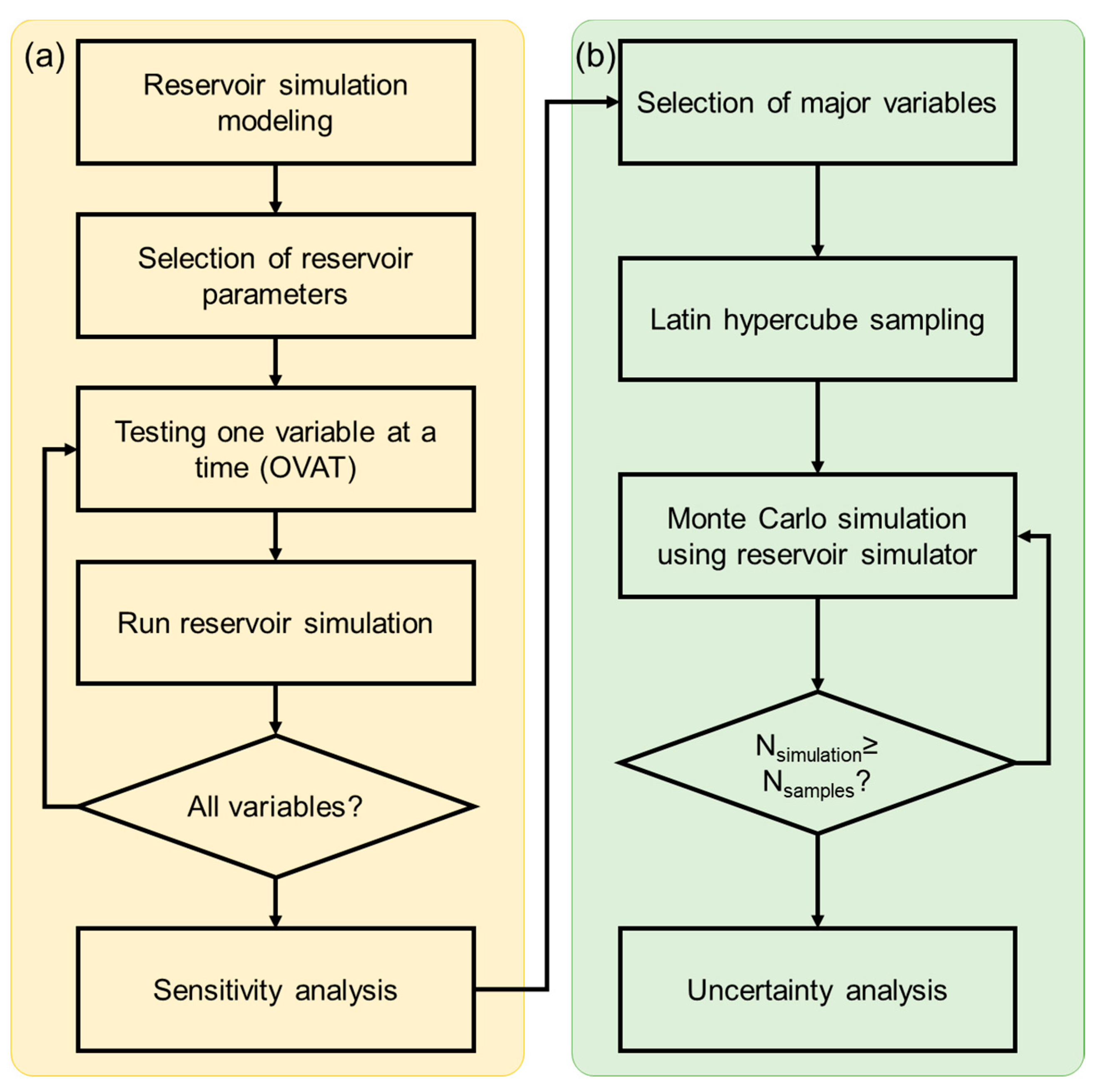
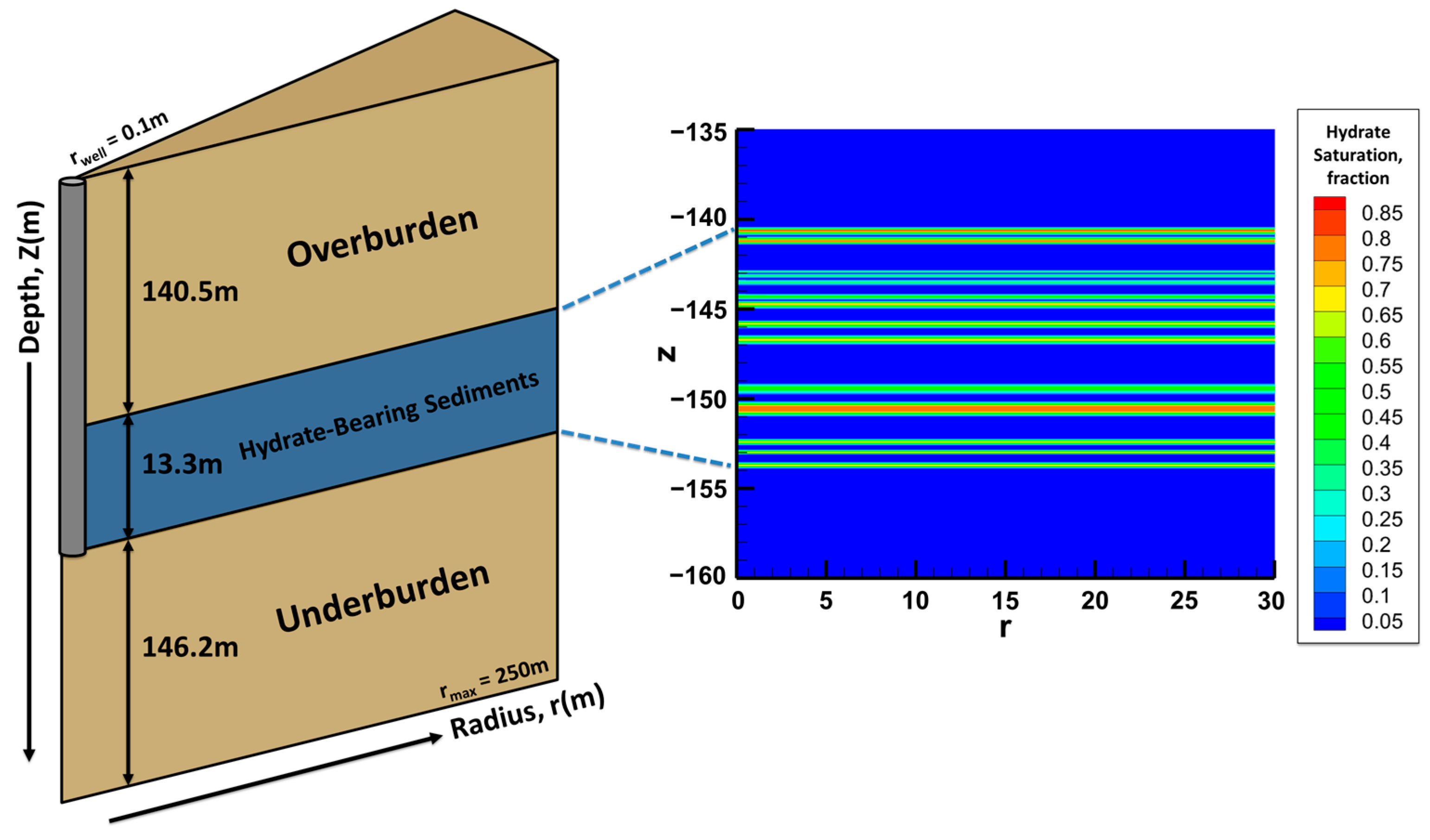

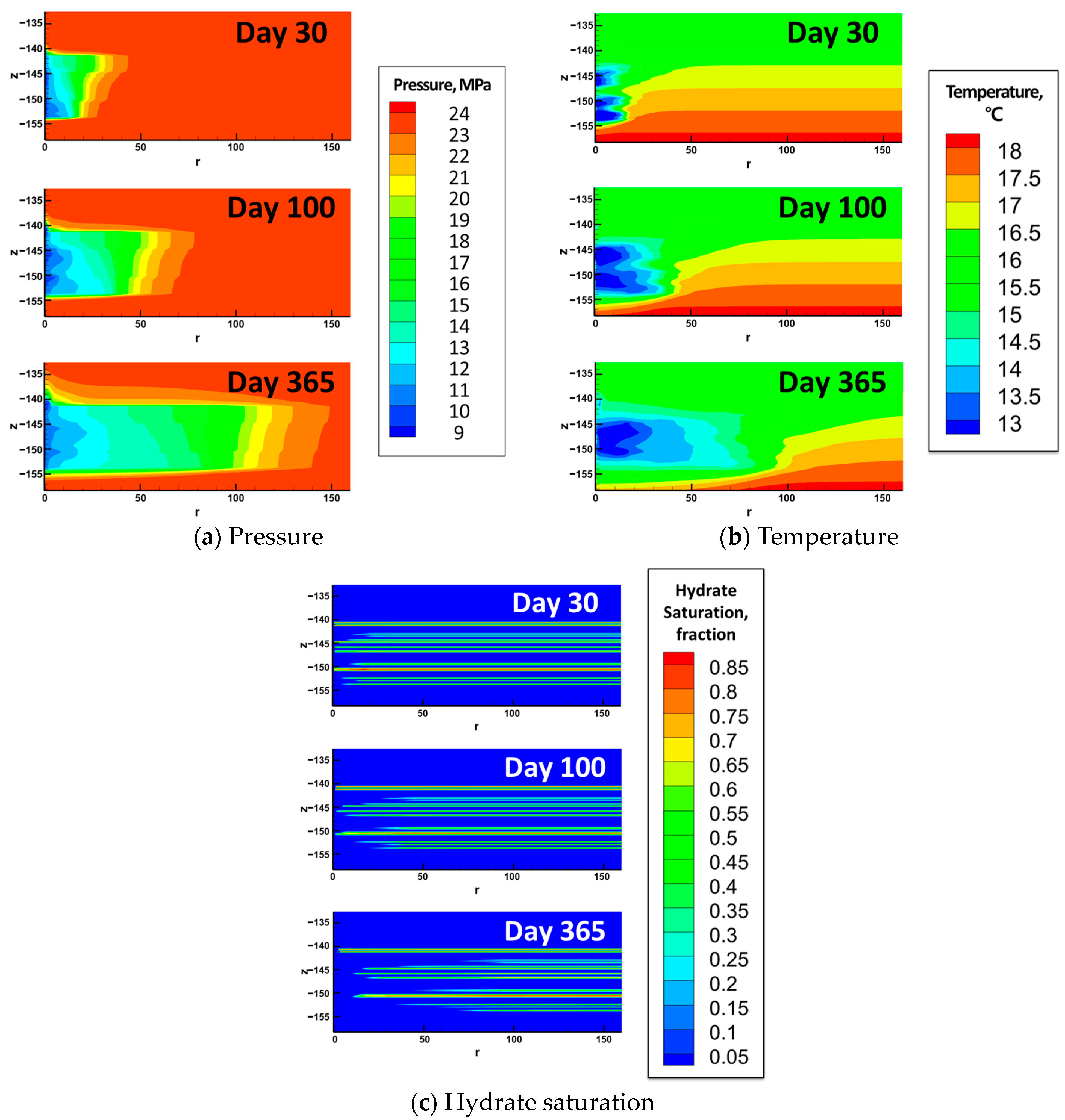

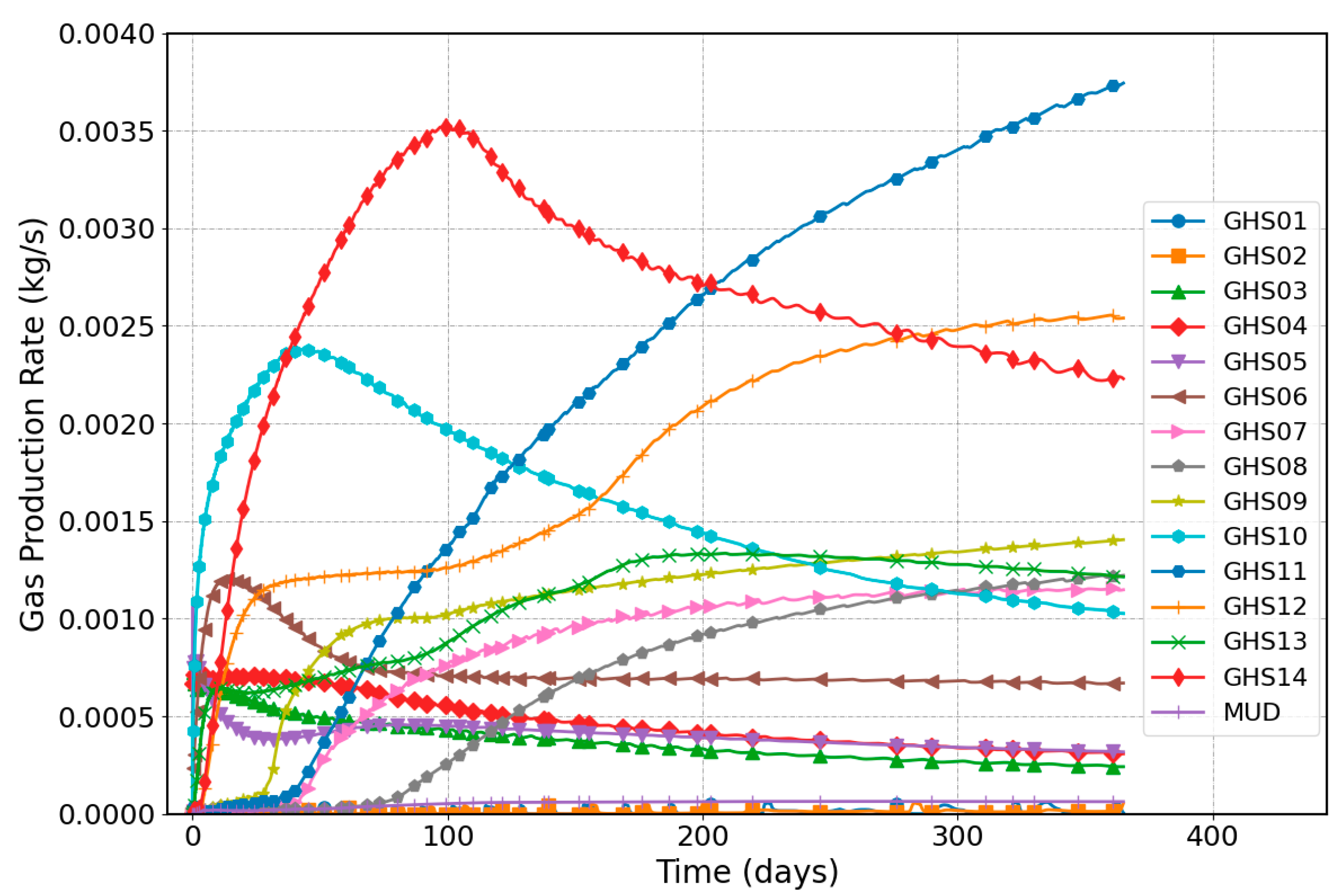
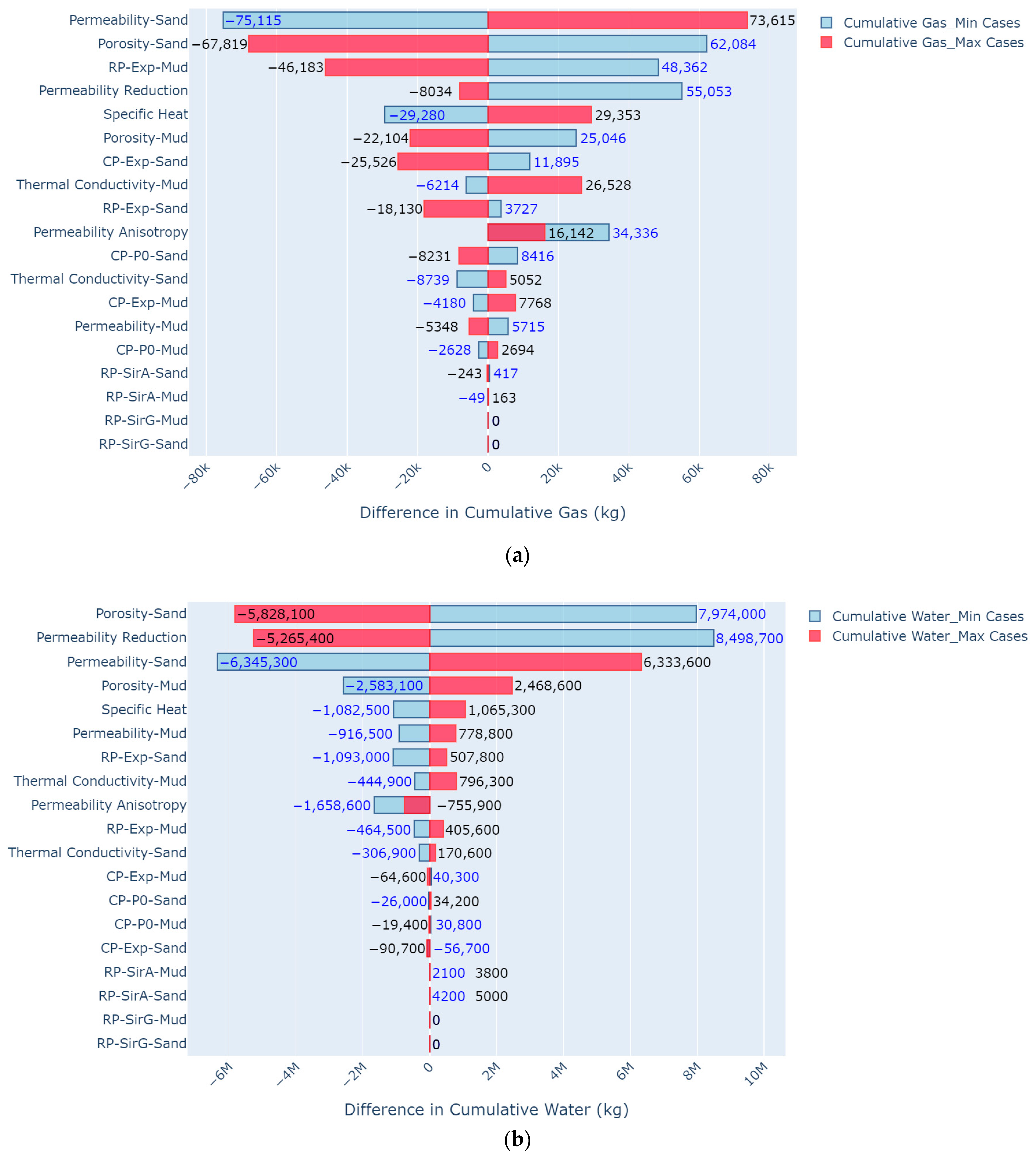

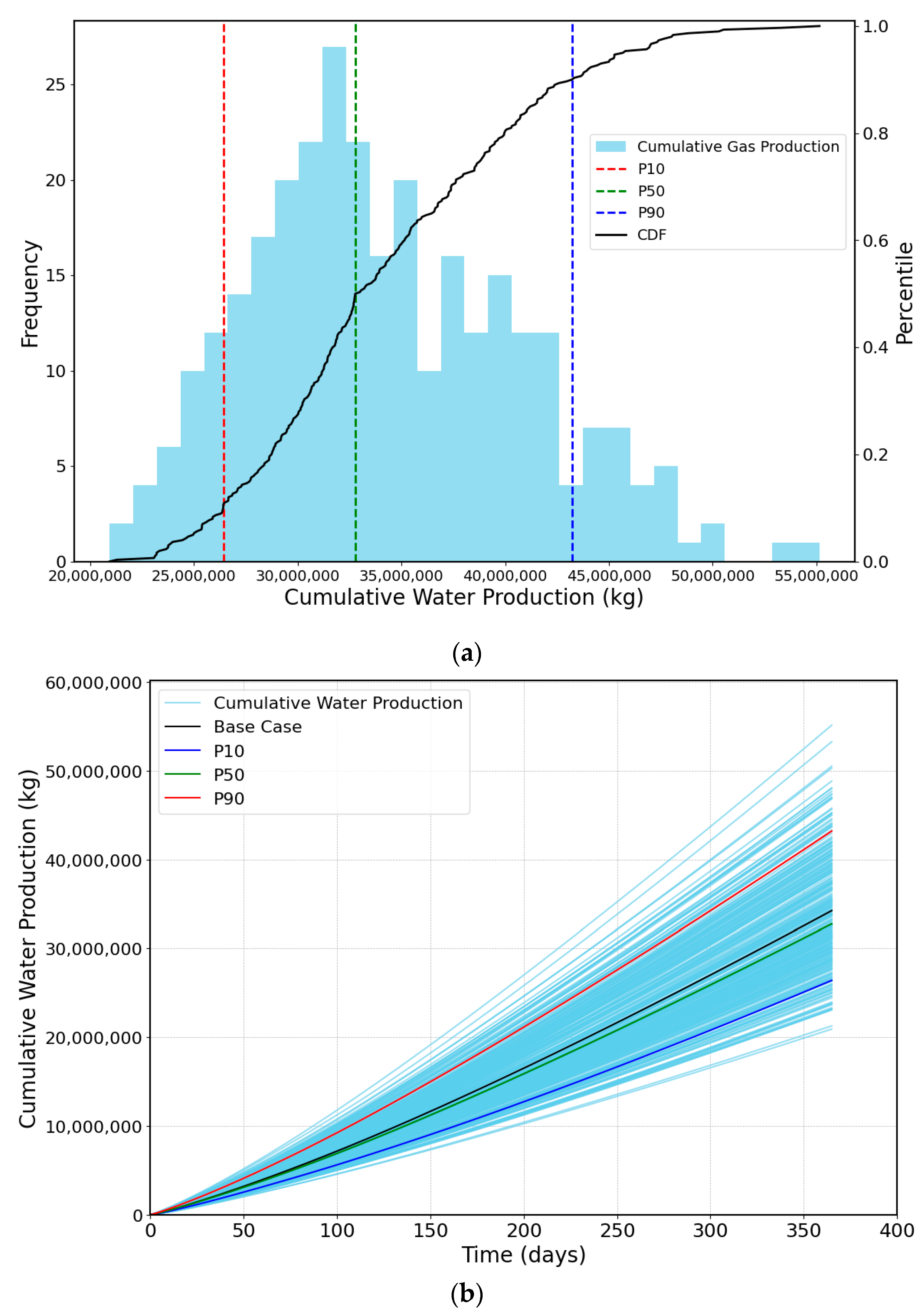
| Parameters | Value | |
|---|---|---|
| Overburden thickness, m | 140.5 | |
| Underburden thickness, m | 146.2 | |
| HBS thickness, m | 13.3 | |
| Porosity, fraction | Sand | 0.45 |
| Mud | 0.67 | |
| Permeability, md | Sand | 180 |
| Mud | 0.2 | |
| Permeability anisotropy ratio | 1 | |
| Permeability reduction factor | 6 | |
| Specific heat | 830 | |
| Thermal conductivity (sand), W/m/k | 1.45 | |
| Thermal conductivity (mud), W/m/k | 1 | |
| Hydrate saturation (sand layer), fraction | 0.388~0.862 | |
| Relative permeability model (van Genuchten) | | |
| Irreducible water saturation () | Sand | 0.1 |
| Mud | 0.1 | |
| Irreducible gas saturation () | Sand | 0.01 |
| Mud | 0.01 | |
| Exponent () | Sand | 0.66 |
| Mud | 0.75 | |
| Capillary pressure model (van Genuchten) | | |
| Exponent () | Sand | 0.66 |
| Mud | 0.75 | |
| , MPa | Sand | 0.01 |
| Mud | 0.02 | |
| Well radius, m | 0.1 | |
| Bottomhole pressure, MPa | 9 | |
| Depressurization rate, MPa/h | 0.5 | |
| Parameters | Range | |||
|---|---|---|---|---|
| Min | Base | Max | ||
| Porosity, fraction | Sand | 0.36 | 0.45 | 0.54 |
| Mud | 0.536 | 0.67 | 0.804 | |
| Permeability, md | Sand | 144 | 180 | 216 |
| Mud | 0.16 | 0.2 | 0.24 | |
| Permeability anisotropy ratio | 0.6 | 0.8 | 1 1 | |
| Permeability reduction factor | 4.8 | 6 | 7.2 | |
| Specific heat | 664 | 830 | 996 | |
| Thermal conductivity, W/m/k | Sand | 1.16 | 1.45 | 1.74 |
| Mud | 0.8 | 1 | 1.2 | |
| Irreducible water saturation () | Sand | 0.08 | 0.1 | 0.12 |
| Mud | 0.08 | 0.1 | 0.12 | |
| Irreducible gas saturation () | Sand | 0.008 | 0.01 | 0.012 |
| Mud | 0.008 | 0.01 | 0.012 | |
| Relative permeability (RP) exponent () | Sand | 0.528 | 0.66 | 0.792 |
| Mud | 0.6 | 0.75 | 0.9 | |
| Capillary pressure (CP) exponent () | Sand | 0.528 | 0.66 | 0.792 |
| Mud | 0.6 | 0.75 | 0.9 | |
| , MPa | Sand | 0.008 | 0.01 | 0.012 |
| Mud | 0.016 | 0.02 | 0.024 | |
| Domain | Thickness, m | Hydrate Saturation, % | Maximum Dissociation Front, m | Cumulative Gas Production, kg |
|---|---|---|---|---|
| GHS 1 | 0.2 | 86.2 | 2 | 303 |
| GHS 2 | 0.3 | 86.2 | 3 | 319 |
| GHS 3 | 0.1 | 38.8 | 82 | 11,668 |
| GHS 4 | 0.1 | 38.8 | 68 | 14,781 |
| GHS 5 | 0.1 | 38.8 | 83 | 12,539 |
| GHS 6 | 0.2 | 54.3 | 36 | 23,379 |
| GHS 7 | 0.3 | 77.7 | 16 | 26,818 |
| GHS 8 | 0.3 | 73.8 | 11 | 21,867 |
| GHS 9 | 0.3 | 73.8 | 18 | 34,054 |
| GHS 10 | 0.3 | 55.1 | 46 | 49,659 |
| GHS 11 | 0.6 | 77.1 | 10 | 68,811 |
| GHS 12 | 0.2 | 74.6 | 36 | 57,395 |
| GHS 13 | 0.1 | 74.6 | 58 | 34,363 |
| GHS 14 | 0.2 | 74.6 | 70 | 82,302 |
| Muds | 10 | 0 | 0 | 1675 |
| Total | 439,932 | |||
| Case | Cumulative Gas Production, kg | Cumulative Water Production, kg |
|---|---|---|
| P10 | 350,720 | 26,411,974 |
| P50 | 454,787 | 32,768,290 |
| P90 | 557,041 | 43,211,756 |
| Base Case | 439,932 | 34,240,600 |
Disclaimer/Publisher’s Note: The statements, opinions and data contained in all publications are solely those of the individual author(s) and contributor(s) and not of MDPI and/or the editor(s). MDPI and/or the editor(s) disclaim responsibility for any injury to people or property resulting from any ideas, methods, instructions or products referred to in the content. |
© 2024 by the authors. Licensee MDPI, Basel, Switzerland. This article is an open access article distributed under the terms and conditions of the Creative Commons Attribution (CC BY) license (https://creativecommons.org/licenses/by/4.0/).
Share and Cite
Kim, Y.; Lee, W. Assessment of Production Performance and Uncertainty in the UBGH2-6 Gas Hydrate Reservoir, Ulleung Basin. J. Mar. Sci. Eng. 2024, 12, 748. https://doi.org/10.3390/jmse12050748
Kim Y, Lee W. Assessment of Production Performance and Uncertainty in the UBGH2-6 Gas Hydrate Reservoir, Ulleung Basin. Journal of Marine Science and Engineering. 2024; 12(5):748. https://doi.org/10.3390/jmse12050748
Chicago/Turabian StyleKim, Youngmin, and Wonsuk Lee. 2024. "Assessment of Production Performance and Uncertainty in the UBGH2-6 Gas Hydrate Reservoir, Ulleung Basin" Journal of Marine Science and Engineering 12, no. 5: 748. https://doi.org/10.3390/jmse12050748






